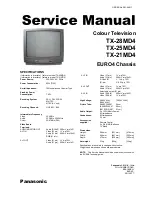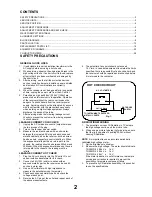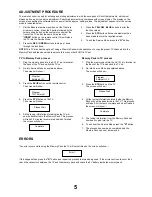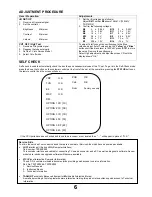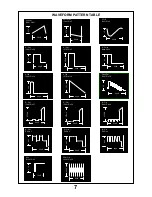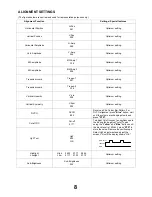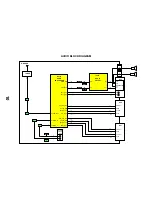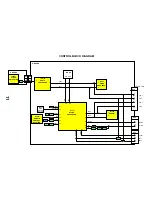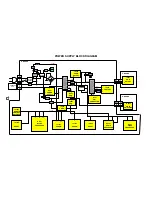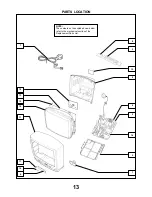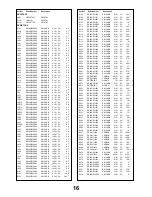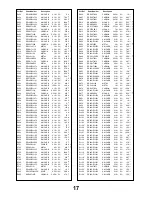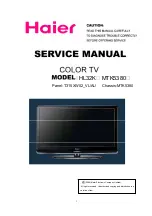
CONTENTS
SAFETY PRECAUTIONS..........................................................................................................................................................2
SERVICE HINTS .......................................................................................................................................................................3
SERVICE POSITION.................................................................................................................................................................4
ADJUSTMENT PROCEDURE...................................................................................................................................................5
ADJUSTMENT PROCEDURE AND SELF-CHECK ..................................................................................................................6
WAVEFORM PATTERN TABLE ...............................................................................................................................................7
ALIGNMENT SETTINGS...........................................................................................................................................................8
BLOCK DIAGRAMS ..................................................................................................................................................................9
PARTS LOCATION .................................................................................................................................................................13
REPLACEMENT PARTS LIST ................................................................................................................................................14
SCHEMATIC DIAGRAMS .......................................................................................................................................................23
CONDUCTOR VIEWS.............................................................................................................................................................28
SAFETY PRECAUTIONS
GENERAL GUIDE LINES
1. It is advisable to insert an isolation transformer in the
AC supply before servicing a hot chassis.
2. When servicing, observe the original lead dress in the
high voltage circuits. If a short circuit is found, replace
all parts that have been overheated or damaged by
the short circuit.
3. After servicing, see that all the protective devices
such as insulation barriers, insulation papers, shields
and isolation R-C combinations are correctly
installed.
4. When the receiver is not being used for a long period
of time, unplug the power cord from the AC outlet.
5. Potentials as high as 29,5kV {29,2kV} [29kV] are
present when this receiver is in operation. Operation
of the receiver without the rear cover involves the
danger of a shock hazard from the receiver power
supply. Servicing should not be attempted by anyone
who is not familiar with the precautions necessary
when working on high voltage equipment. Always
discharge the anode of the tube.
6. After servicing make the following leakage current
checks to prevent the customer from being exposed
to shock hazard.
LEAKAGE CURRENT COLD CHECK
1. Unplug the AC cord and connect a jumper between
the two prongs of the plug.
2. Turn on the receiver’s power switch.
3. Measure the resistance value with an ohmmeter,
between the jumpered AC plug and each exposed
metallic cabinet part on the receiver, such as screw
heads, aerials, connectors, control shafts etc. When
the exposed metallic part has a return path to the
chassis, the reading should be between 4M ohm and
20M ohm. When the exposed metal does not have a
return path to the chassis, the reading must be
infinite.
LEAKAGE CURRENT HOT CHECK
1. Plug the AC cord directly into the AC outlet. Do not
use an isolation transformer for this check.
2. Connect
a
2k
Ω
10W resistor in series with an
exposed metallic part on the receiver and an earth,
such as a water pipe.
3. Use an AC voltmeter with high impedance to
measure the potential across the resistor.
4. Check each exposed metallic part and check the
voltage at each point.
5. Reverse the AC plug at the outlet and repeat each of
the above measurements.
6. The potential at any point should not exceed
1.4 Vrms. In case a measurement is outside the limits
specified, there is a possibility of a shock hazard, and
the receiver should be repaired and rechecked before
it is returned to the customer.
X-RADIATION WARNING
1. The potential sources of X-Radiation in TV sets are
the high voltage section and the picture tube.
2. When using a picture tube test jig for service, ensure
that the jig is capable of handling 29,5kV without
causing X-Radiation.
NOTE: It is important to use an accurate periodically
calibrated high voltage meter.
1. Set the brightness to minimum.
2. Measure the high voltage. The meter should indicate.
TX-28MD4 28,5kV ±
1kV.
TX-25MD4 28,2kV ± 1kV.
TX-21MD4 28kV
± 1kV.
If the meter indication is out of tolerance, immediate
service and correction is required to prevent the
possibility of premature component failure.
3. To prevent any X-Radiation possibility, it is essential
to use the specified tube.
HOT CHECK CIRCUIT
A.C. VOLTMETER
WATER PIPE
(EARTH)
TO INSTRUMENT’S EXPOSED
METALLIC PARTS
Fig. 1.
2k
Ω
10 Watts
2



